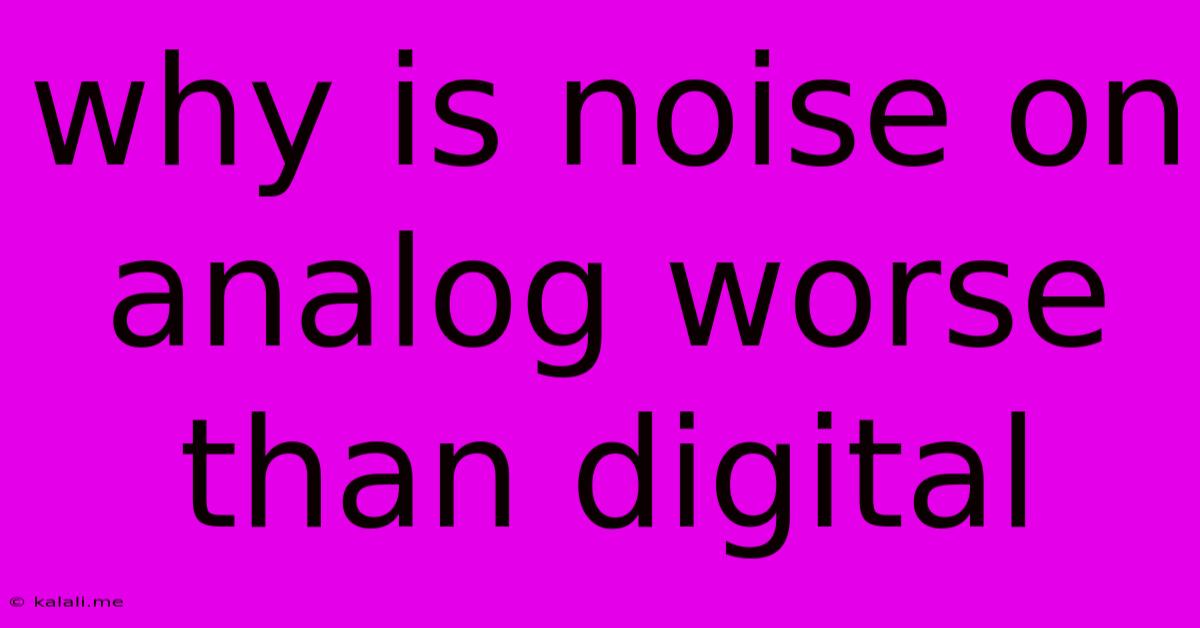Why Is Noise On Analog Worse Than Digital
Kalali
Jun 01, 2025 · 3 min read

Table of Contents
Why is Noise on Analog Worse Than Digital? A Deep Dive into Audio Fidelity
The age-old debate: analog vs. digital. While both offer unique sonic characteristics, one area where digital significantly surpasses analog is in noise handling. But why is noise on analog recordings demonstrably worse than on their digital counterparts? This article delves into the technical reasons behind this difference, exploring the nature of noise in both formats and explaining why digital offers a clearer, quieter listening experience.
Understanding Noise in Audio
Before comparing analog and digital noise, it's crucial to define what we mean by "noise" in the context of audio reproduction. Noise represents unwanted sounds or signals that interfere with the desired audio signal, degrading its fidelity and clarity. This can manifest as hiss, hum, crackle, or other unwanted artifacts.
The Nature of Analog Noise
Analog recordings, whether on vinyl, cassette tapes, or reel-to-reel, inherently introduce noise during the recording and playback processes. Several factors contribute to this:
-
Thermal Noise: This fundamental noise is generated by the random movement of electrons in electronic components. It's present in all electronic systems, including analog recording equipment. The warmer the component, the higher the thermal noise.
-
Tape Hiss: Magnetic tape, a staple of analog recording, introduces its own unique type of noise often described as "hiss." This is caused by the inherent graininess of the tape and the limitations of the magnetic recording process.
-
Wow and Flutter: These are variations in playback speed, resulting in pitch fluctuations that are audible as a wavering or unevenness in the sound. This is especially prevalent in older cassette players and reel-to-reel machines.
-
Surface Noise: Vinyl records, while cherished by audiophiles, are susceptible to surface noise—clicks, pops, and crackles—caused by dust, scratches, or imperfections in the vinyl itself. This noise can significantly distract from the music.
-
Crosstalk: In multi-track analog recording, unintended bleed-through of signals from one track to another (crosstalk) adds noise and degrades separation between instruments or vocals.
The Advantages of Digital Noise Reduction
Digital audio employs a fundamentally different approach to recording and storing sound. Instead of capturing the audio signal as a continuous wave, it samples the signal at discrete intervals and converts these samples into digital data. This process allows for remarkable noise reduction capabilities:
-
Quantization Noise: While digital audio does introduce a type of noise called quantization noise, it's significantly less audible than analog noise. This is because the quantization noise is spread across the entire frequency spectrum, making it less prominent than the localized and often intense noise found in analog recordings. Higher bit depths (e.g., 24-bit) further minimize this effect.
-
Error Correction: Digital audio formats often incorporate error correction codes. These codes detect and correct errors introduced during the recording, storage, or transmission process, further reducing the impact of noise.
-
Digital Signal Processing (DSP): Powerful DSP techniques can be applied to digital audio to further reduce noise. Algorithms can identify and remove or reduce various types of noise, resulting in a cleaner, more pristine sound.
Conclusion: Why Digital Wins the Noise Battle
In summary, the superior noise performance of digital audio stems from its inherent nature and the advanced noise reduction techniques available. While analog recordings offer a certain warmth and character appreciated by many, the unavoidable noise introduced by the analog recording process is significantly more prominent and disruptive than the quantization noise in digital audio. This is why, for overall clarity and a quieter listening experience, digital reigns supreme in the fight against unwanted audio noise. The advancements in digital audio technology continue to improve signal-to-noise ratios, making the digital audio experience ever cleaner and more enjoyable.
Latest Posts
Latest Posts
-
Thunderbolt Display Monitor Macbook Pro 2019 Disconnects Randomly
Jun 03, 2025
-
How To Remove A User From A Group In Linux
Jun 03, 2025
-
Closed Cell Spray Foam Vs Open Cell Spray Foam
Jun 03, 2025
-
Where To Find The Goblin Tinkerer
Jun 03, 2025
-
What To Do With Used Motor Oil
Jun 03, 2025
Related Post
Thank you for visiting our website which covers about Why Is Noise On Analog Worse Than Digital . We hope the information provided has been useful to you. Feel free to contact us if you have any questions or need further assistance. See you next time and don't miss to bookmark.